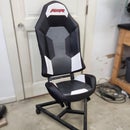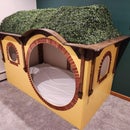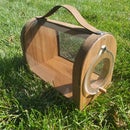Introduction: Single Player Arcade Pedestal
I plan to make a full size arcade cabinet in the future after I am done with school but at the moment I typically play games using my computer hooked up to my TV. I usually use a controller but with some of the games, I wanted to have a more authentic arcade experience. I have seen lots of two or four player pedestals but I haven't seen any small one person designs. I designed this pedestal that will allow me to sit on the couch and have the joystick and buttons in front of me. This is just the design for this pedestal as I have not made it yet.
This is designed to be made out of 3/4 inch thick plywood or mdf. All pieces are no longer than 24 inches making it possible to make out of smaller pieces of wood instead of a full sheet of plywood. You should be able to make a simplified version by having your hardware store cut the boards and then just screw it together. It stands at almost 25 inches tall making it about the same height as a tv tray. If you wanted to make it wider, you could make it into a two player pedestal.
Supplies
3/4 inch plywood or mdf
Table saw or circular saw
Sander or sandpaper
Drill and 1 1/8 spade or forstner bit
nails or screws for assembly
Arcade buttons
Arcade joystick
Step 1: Side Panels
The two sides panels are the same. They are 12 inches by 24 inches with a radius cutout on each side. That cutout is optional and just there for aesthetics.
Step 2: Top Panel
The top panel is 13 inches by 24 inches. It could be 12 inches deep if you want to make this out of 12 x 24 inch panels, I just wanted to give it some overhang on the front and back.
For the button and joystick spacing, I found a bunch of charts online that give you various button layouts. I liked this one the best as I felt it had the best spacing and shape but you can look up alternative spacing if you want. I set the button spacing and then moved them together to place it in middle of the top. All holes are 1 1/8 inch diameter to fit the buttons and joystick.
I also included three buttons at the top to assign various functions.
Step 3: Top Skirt
I added a board on the front and back to conceal the wiring and electronics. I didn't think I needed a bottom panel so I can easily access everything but you can enclose it if you want.
Step 4: Bottom Panel
To stabilize this pedestal, I made a 11 x 20 inch panel to go on the bottom between the legs. I added some radius cutouts like the leg as well but are not needed if you want to keep it simple.
Step 5: Assembly Check
Before I cut anything, I wanted to make sure everything fit together well and there wasn't any interferences. I created an assembly with all the parts and added models for the buttons and joystick. Everything fits together well.
Step 6: Hardware and Wiring
For the buttons and joystick, you will need a DIY arcade kit like THIS ONE that comes with buttons, a joystick, and a control board.
Attach the buttons and joystick into their holes and mount the board on the underside of the top panel and then connect the buttons to the K1-K12 terminals (it doesn't matter the order as you will map them in your system) and then connect the joystick into it's terminal at the bottom.
These kits make it super simple to make and all that is left is to connect it to your system and map out the buttons and then enjoy.
Step 7: Design STEP Files
Here are the .step files for anyone who would like to use or modify this design.








